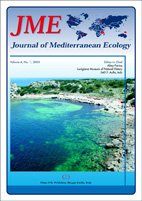JME 2003 1
Mediterranean rangeland response to human intervention: a remote sensingand GIS study
Tal Svoray, Maxim Shoshany, Avi Perevolotsky
Human intervention in Mediterranean and semi-arid ecosystems results in complex vegetation patterns and threat for soil degradationand deterioration of primary production. Range management of large areas under such conditions requires adequate and updatedinformation regarding the status and dynamics of vegetation patterns. This paper investigates the usefulness of Landsat TM andJERS-1 satellite images for determining effects of goat grazing and clearing treatments on the recovery processes of Mediterraneanshrubland. Eight slope units representing different histories of grazing pressures and clearing treatments were selected for thispurpose. Spatial variations of vegetation cover, as determined by NDVI (Normalised Difference Vegetation Index) distributions inthe slope units, were analyzed on the basis of summer images from 1992 and 1997. The use of temporal data allowed the assessmentof natural vegetation regrowth rates. The results show that image statistics correspond well with: grazing intensities; length of theregrowth process; and grazing habits of goat herds. Proximity analysis conducted using GIS (Geographic Information Systems)techniques revealed that grazing intensity pattern follows the shortest path connecting the water source and the corral rather thanspreading in wide areas across the slopes. It is suggested that remote sensing and GIS analysis can be used for monitoring slope-scale impacts of grazing and treatments on woody vegetation such as Mediterranean scrubland and woodland.
Keywords: Satellite, goat grazing, grazing intensities, clearing treatments, landscape heterogeneity
D. G. Angeler, S. Sánchez-Carrillo, M. Alvarez-Cobelas, S. Cirujano & L. Medina
Charophytes can comprise the dominant submerged vegetation in highly fluctuating wetlands. However the exotic crayfish,Procambarus clarkii Girard, eradicated submerged vegetation in many shallow aquatic ecosystem, moving them between stablestates. In this study we aimed at elucidating how such crayfish induced changes can impact abiotic ecosystem processes. Employingenclosures we provided snap shots of water quality characteristics (total phosphorus, total nitrogen, chlorophyll a, and total suspendedsolids) 1) in the presence of charophytes and absence of crayfish (simulation of the clear water state; charophyte treatment), 2)when crayfish herbivory eliminates charophytes (transition between alternative stable states; charophyte x crayfish treatment), and3) when crayfish has eliminated entirely submerged vegetation (reflecting the turbid state; crayfish treatment). Results indicatethat the synergistic action of crayfish bioturbation and feeding mode are involved in water quality decline. However the magnitudeof the decline was correlated chiefly with crayfish feeding. Crayfish herbivory substantially decreased Chara beds in the charophytex crayfish treatment enclosures, but had no effects on nutrient and chlorophyll a concentrations. On the other hand, crayfishdetritivory in crayfish treatment significantly increased nutrients a likely result of translocation of sediment-bound nutrients to thewater column. Water quality decline due to bioturbation, i.e., increased non-algal turbidity due to sediment resuspension, occurredwhether or not charophytes were present in the enclosures. The potential implication of our results in the context of alternativeequilibria in wetland ecosystems is discussed.
Keywords: freshwater crayfish, water quality, charophytes, aquatic ecosystem health
Pérez-Fernández, M. A., Rodríguez-Echeverría, S., Calvo-Magro, E. & David-Antonio, C.
Imbibed seed of six common species from the Central West of Spain were placed in Petri dishes in moist soils and heated in ovensset to 30oC, 50 oC and 100 oC for 0.5, 1, 4, 8 and 16 days. After heating, seeds were incubated for 35 days on a 10/14 dark/lightregime and germination was recorded. The same duration of heating treatment was applied to non-imbibed seeds. It was alsoinvestigated the effect of nitrogen on germination, by applying NaNO2, NH4NO3, KNO3 and NH4Cl at five increasing concentrations(1mM, 10mM, 25 mM, 50mM and 100mM). Temperature of 30oC was the most successful for germination of pre-imbibed seeds.Dittrichia viscosa, Cistus albidus and Cistus ladanifer increased germination under the wet treatment. Germination is positivelycorrelated to soil water content for the aforementioned species and negatively correlated in Verbascum sinuatum. Germination washigher after treatment at 30oC and 50oC that at 100oC for non-imbibed seed except for Cynara humilis and Cistus albidus. Themaximum temperature required to prevent germination varied among species and was variable with duration of heating. Fertilisationwith KNO3 and NH4Cl at 25mM and NH4NO3 at 10mM and 100 mM increased both level and rate of germination in most species.Continuous darkness inhibited germination in all the species. The increase of temperature activates the germination of non-imbibedseeds and also the increase of nitrogenous compounds in the field trigger the germination of nutrient-requiring species.
Keywords: germination, imbibition, desiccation, temperature, nitrogen, light and dark.
The seasonal impact of Cytisus striatus on soil fertility and the herbaceousunderstory
S. Rodríguez-Echeverría & M. A. Pérez-Fernández
Cytisus striatus is an endemic shrubby legume from western Spain that grows on acidic and rocky soils forming extent shrublands.The shrub’s effect on soil fertility and herbaceous species diversity and growth was studied in a natural population from central-western Spain. The concentrations of soil organic matter, nitrogen and phosphorus were higher under Cytisus striatus canopy.Herbaceous species in the understorey had higher nitrogen content than those growing in between shrubs. Isotopic nitrogen analysesdid not show a direct relationship between symbiotic nitrogen fixation on C. striatus and the nitrogen content of herbaceousspecies. The presence of shrubs had a negative effect on herbaceous richness and diversity in its understorey. However, herbaceousdiversity in the ecosystem was increased due to the spatial heterogeneity created by the shrubs. The biomass produced by herbaceousspecies was lower under a dense shrub canopy than in areas without shrubs. It is proposed that intense competition could beresponsible for these results, with Poaceae and Asteraceae outcompeting other species under a dense C. striatus canopy.
Keywords: acidic soils, competition, Cytisus striatus, nitrogen, 15N, patchiness, shrubby legumes
